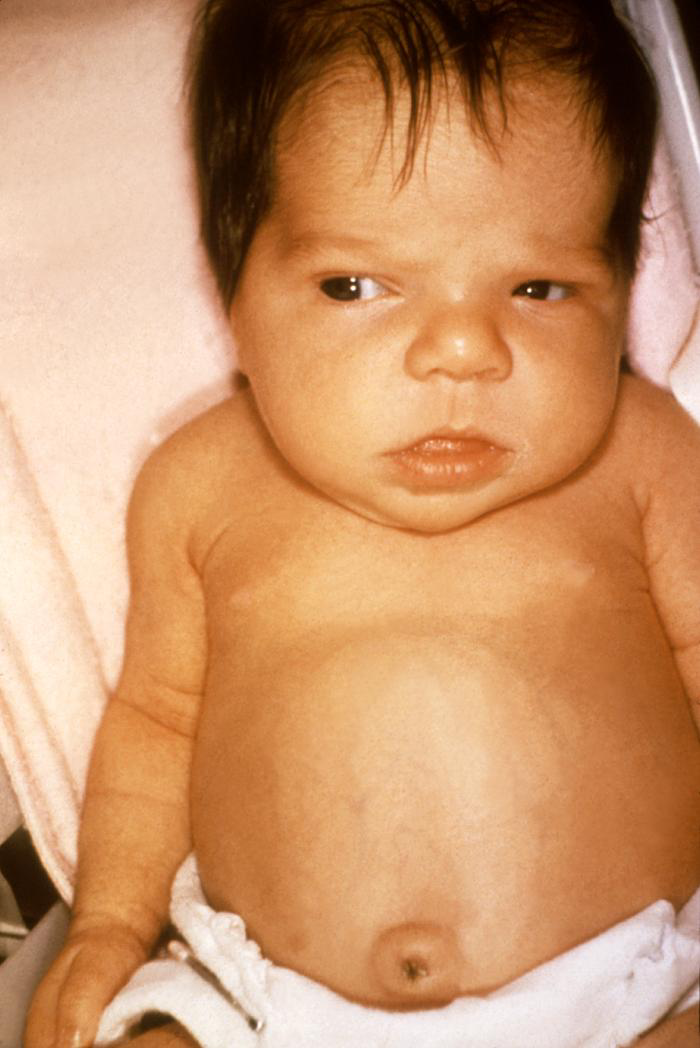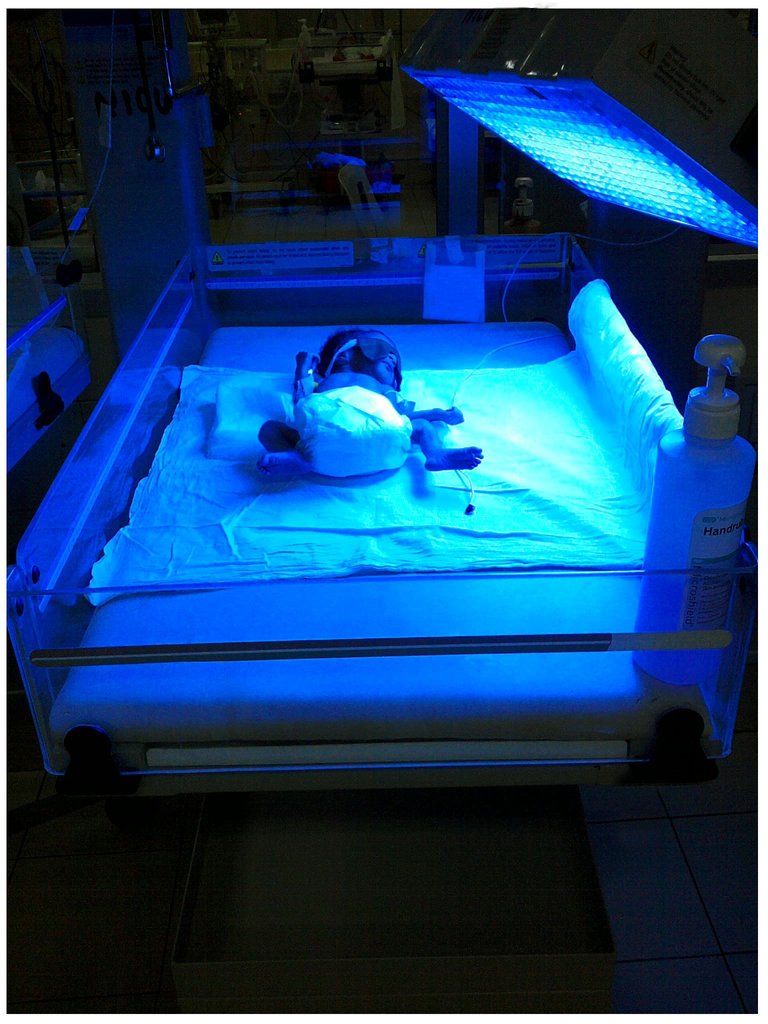Jaundice in the newborn: Types, causes and Treatment.

By Dr Hudson -
CDC ID#: 5604) US Department of Health and Human Services, Public Domain, Wikimedia
Neonatology is the study of children born within the neonatal period.
The neonatal period is the period between the first minute of birth and the 28th day of life
During this period, newborns are prone to different types of conditions and early detection and diagnosis can help reduce disease severity, death and complication.
So during my one month in the neonatology unit, I observed that one of the most common conditions that patients come in with is Neonatal jaundice.
I am sure you must have heard it. I remember hearing this first from my mother while I was in SS3.
She told one of our neighbours who was bothered about the yellowness of her daughter's skin on the 3rd day of life.
In today's post, I will be exploring the topic of jaundice in newborns.
What is neonatal jaundice?
The word jaundice was coined from the French word jaune which means yellow.
Neonatal jaundice is simply the yellowish discolouration of the skin and eye of a newborn due to a high level of bilirubin in the blood.
Bilirubin is a product of the breakdown of haemoglobin.
Haemoglobin is found in red blood cells(RBC) and when RBCs die, they release haemoglobin.
Haemoglobin is then broken down to bilirubin.
What are the different types of neonatal Jaundice
Jaundice in the newborn could be physiological or pathological
Physiological jaundice is jaundice that happens due to the normal functioning of the body. This type of jaundice is usually mild and transient. This is the common one that most people know. However, a lot of people mistake it for pathologic jaundice.
Pathologic jaundice is the main global problem. This is jaundice due to pathology.
The pathology could be due to blood group incompatibility between the mother and child.
It could also be due to an underlying infection.
Glucose-6-phosphate dehydrogenase is an enzyme that helps in preventing red blood cells from getting broken down through a series of complex systems.
The enzyme can be deficient and when this happens, it presents in its early form as neonatal jaundice.
Most of the pathologies lead to break down of red blood cells which lead to excess bilirubin.,
The most important thing to note is jaundice on the first day is always pathologic and prompt hospitalisation is the next thing.
What causes neonatal jaundice?
A lot of things are responsible for jaundice in the newborn and they include;
- ABO incompatibility
- G6PD deficiency
- Infections
- Prematurity
ABO incompatibility happens when the baby's blood group is not the same as the mother's blood group. This usually happens when couples have different blood groups(the mother is O+ and the father is either A+ or B+ and the child is A+ or B+).
This incompatibility results in the breakdown of the red blood cells of the baby by the mother's antibodies.
G6PD deficiency is what I talked about earlier. It has been seen to occur more in male neonates. With this condition, there are things the mother is meant to be careful with when taking care of her child.
Medications that cause the breakdown of RBC can worsen jaundice and lead to serious complications.
Fava beans have also been implicated to exaggerate the symptoms in G6PD deficient babies.
A child that is born before 37 weeks of gestation is at a higher risk of developing jaundice.
While growing up, my mother used dusting powder for me after taking my bath to prevent me from having rashes.
If this powder is applied to newborns, it can exaggerate the breakdown of red blood cells and so all newborns should not use menthol containing products.
Camphor which is been used to preserve clothes has been implicated in causing jaundice in newborns. This should also not be used too.
How does neonatal jaundice happen?
Jaundice in the newborn is mostly due to hemolysis and it is very common in newborns because of the immaturity in the pathway for the metabolism of bilirubin.
Like I earlier said, bilirubin is formed from the breakdown of haemoglobin in red blood cells.
When haemoglobin is broken down to bilirubin, it is unconjugated.
Unconjugated bilirubin is fat-soluble and is capable of crossing membranes.
The most important membrane is the blood-brain barrier and this is because bilirubin is toxic to the brain.
When bilirubin is formed, it is bound to albumin which is a protein.
When bilirubin is bound to a protein, it is not dangerous. This is because bilirubin bound to albumin can't cross any membrane.
When the total albumin is saturated and there is no binding site for bilirubin, jaundice occurs.
Also when medications that require albumin compete with bilirubin and displace bilirubin from the site, jaundice occurs.
This type of jaundice is called unconjugated hyperbilirubinemia.
The liver is responsible for making the fat-soluble bilirubin, water-soluble. This process is called conjugation.
The importance of this is that conjugated bilirubin can be excreted via the kidneys and stool.
If the liver can perform the function of conjugation but there is a problem with it getting to the kidneys or intestine for excretion, conjugated hyperbilirubinemia occurs.
The focus of neonatal jaundice is mainly unconjugated hyperbilirubinemia.
Symptoms of neonatal jaundice
The obvious symptom of neonatal jaundice is yellowness of the eye and skin.
When the yellowness comes with a greenish tinge, it most likely is caused by conjugation issues. The greenish tinge is most likely due to the accumulation of bile.
Other symptoms to watch for include fever, high pitched cry and cycling movement.
Like I earlier said, infection is a common cause of neonatal jaundice and most infections are evidenced by a high body temperature.
Cycling movement in a newborn is a sign of advanced disease. This sign almost always means that bilirubin has entered the brain of the child.
High pitched cry also known as cat cry is another feature of advanced disease. The cry sounds like a cat cry with so much persistence.
Bilirubin is neurotoxic
Treatment of Neonatal jaundice

By Vtbijoy - Own work, CC BY-SA 3.0, Wikimedia
The treatment options for neonatal jaundice is dependent on the level of bilirubin in the blood.
Usually, if the bilirubin level is greater than 20mg/dL an exchange blood transfusion is required.
An exchange blood transfusion is a procedure that involves exchanging the baby's blood with fresh whole blood that is compatible with the baby.
This method is very effective in crashing bilirubin levels.
Another method is phototherapy. Bilirubin is photosensitive meaning it breaks down when it is exposed to light.
This wave and intensity of the light are necessary for having an effective breakdown of bilirubin.
Complication of neonatal jaundice
The most serious complication of neonatal jaundice is called kernicterus.
Kernicterus is a condition in which bilirubin has leaked into the brain causing symptoms of toxicity into the brain.
Children who have kernicterus manifest with delayed developmental milestones, mental retardation and sometimes cerebral palsy.
Take home points.
- Neonatal jaundice on the first day of life is pathologic.
- Neonatal jaundice could be physiologic or pathologic.
- Physiologic jaundice clears up with proper feeding.
- Pathologic jaundice could either be unconjugated or conjugated hyperbilirubinemia.
- Unconjugated hyperbilirubinemia is more dangerous in terms of brain dysfunction.
- Conjugated hyperbilirubinemia is due to failure of transport and excretion of the conjugated bilirubin.
- The most important complication of unconjugated hyperbilirubinemia is kernicterus
- Treatment options available include phototherapy and exchange blood transfusion.
Thank you for reading.
References
- Nelson's textbook of paediatrics; 7th edition
- Heathline
- The paediatrics guide
Wow
Do you know I thought a child gets jaundice only when the mother suffers from malaria a lot during pregnancy.
Now I have the proper information.thanks
Thank you for stopping by... I am happy you learnt something...
I learned a lot from this, my family friend lost his child due to jaundice, and no one really knew much about it.
So sorry. But rearly will the jaundice kill the child,from experience there was probably something else causing the jaundice which eventually led to the child's death. Jaundice is just a sign.
And to some extent it could be normal. Physiologic jaundice.
I think there was some liver problem attached but they didn't also realize the connection until it was too late.
Yeah.. Thats must have been a pathologic jaundice.
Sad they didnt pick the connection quickly.
For little kids.. A high level of diagnostic suspicion is usually employed and there are certain other signs to detect them.
I guess the hospital was incompetent or they didn't take note.
I can't really say.. So sorry.
I don't like hearing that babies died.
Yeah, it is sad.
You have. Done well to move so much stuff..here chief.
Let me expose some practices done in the rurals ..here in Nigeria
In the past and even in the present day in some rural areas, mothers feed their children pawpaw water.. Newborns ooo. They believe it will reduce the jaundice. It doesnt.
Some spread their babies in the sun, usually early morning sun, this predisposes the baby to dehydration and other infections.
Mothers who use camphor for baby cloth preservation will also predispose their babies to this because it will also act like the drug @bhoa mentioned.
It is also known that breastfeeding the baby enhances enterohepatic circulation (blood flow to the liver from the stomach) which help to reduce the bilirubin concentration.
So while the child is receiving photo therapy (which should be measure Ultra violet light) the child also gets food, breast or artificial pending on the mother lactating and if the child can suck.
@bhoa .. I miss neonatology, did you get to do EBT?😂😂😂
Thank you chief for stopping by..
Well, I didn't do EBT in neonatology.. I escaped it as much as I could.
However, I did it in haematology-oncology unit
Congratulations @bhoa! You have completed the following achievement on the Hive blockchain and have been rewarded with new badge(s):
Your next target is to reach 400 posts.
You can view your badges on your board and compare yourself to others in the Ranking
If you no longer want to receive notifications, reply to this comment with the word
STOPTo support your work, I also upvoted your post!
Check out the last post from @hivebuzz:
Support the HiveBuzz project. Vote for our proposal!
Well written and simplified for non-medical folks like myself. I have heard cases of jaundice several times, including a recent case involving a friend.
Thank you for your encouraging comment
Thanks for your contribution to the STEMsocial community. Feel free to join us on discord to get to know the rest of us!
Please consider delegating to the @stemsocial account (80% of the curation rewards are returned).
Please consider including @stemsocial as a beneficiary to get a stronger support.
Thanks for sharing this very clear text with us!
I have definitely heard about it too, and even been into it through my sons (it was the physiological one). The colour of the eyes where the most scary part, in my opinion. It was fixed after a couple of days (and some sessions of phototherapy).
Oh.. Thank God it was physiological
I also appreciate your presence on my post. I am honored
The pleasure was for me :)
My first-born son had jaundice. He had to be wrapped in a UV blanket before being released to the hospital.
Oh wow.. I am happy you can relate to the post.....
Well written :) Thank you. Those days are long past for me...children and granddaughter safely delivered, thankfully. Useful information for those who still have these dramatic events ahead of them.
Thank you for stopping by.
Will probably write my next post on something that affects the elderly folks.
Stay tuned..
Benign prostatic enlargement